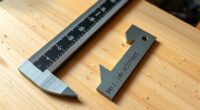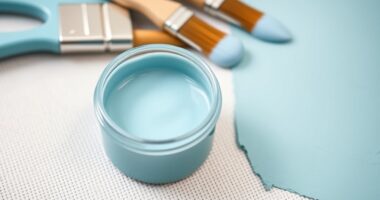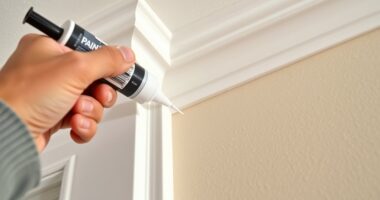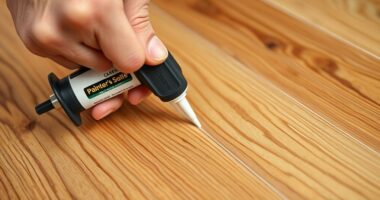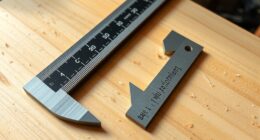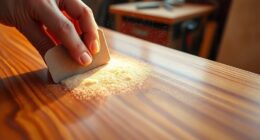To prevent brush strokes and drips in furniture painting, use light, controlled strokes with a well-loaded but not overloaded brush. Maintain a smooth, steady hand and work in small sections, blending each stroke before it dries. Thin your paint if needed and test it on scrap first. Keep brushes clean and appropriate for your paint type. Focusing on application technique and consistency guarantees a professional-looking finish, and you’ll discover more tips to perfect your project as you continue.
Key Takeaways
- Use light, controlled strokes with a lightly loaded brush for smooth, even coverage.
- Maintain a consistent paint flow by testing and thinning the paint as needed before application.
- Work in manageable sections with long, continuous strokes following the wood grain to prevent streaks.
- Keep brushes clean and well-maintained to ensure optimal paint flow and minimize marks.
- Feather edges and blend each stroke while wet to avoid visible brush marks and drips.
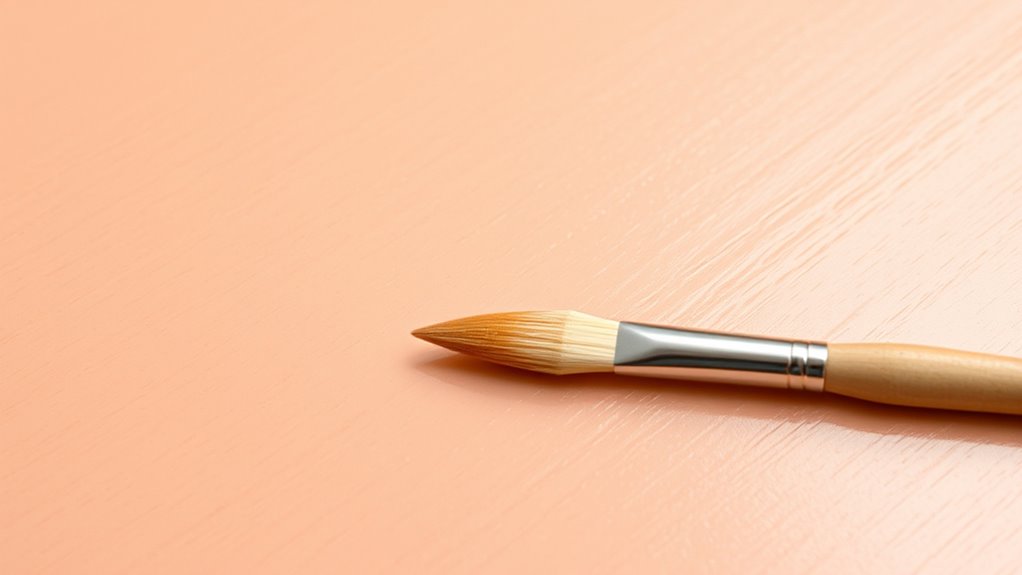
Achieving a smooth, professional finish when painting often depends on preventing brush strokes and drips. The way you handle your brush and the consistency of your paint play vital roles in achieving that flawless look. Your brush technique can make all the difference; a steady hand and controlled strokes help guarantee an even layer of paint. Instead of applying excessive pressure or going over the same spot repeatedly, use light, smooth strokes to distribute the paint evenly. Start with a few careful strokes, then gently feather out the edges to avoid thick build-ups that lead to drips or brush marks. Keep your brush loaded with just enough paint—overloading causes pooling and visible brush strokes, while underloading can result in streaks or uneven coverage.
Use light, controlled strokes and keep your brush lightly loaded for a smooth, professional finish.
Paint consistency is equally important. If your paint is too thick, it’s more likely to leave visible brush strokes and cause drips, especially on vertical surfaces. To avoid this, always stir your paint thoroughly and consider thinning it slightly with a compatible medium or water, depending on the type of paint you’re using. The goal is a smooth, fluid consistency that glides easily over the surface. When your paint flows smoothly off the brush, you’re less likely to see brush marks and more likely to achieve a polished finish. Test the consistency on a scrap piece or a hidden area before starting on your furniture. If the paint drags or leaves streaks, thin it further until it flows evenly.
Maintaining proper paint application techniques and consistent paint flow are essential steps in preventing unwanted marks and drips. The application technique also matters. Work in manageable sections and maintain a wet edge by blending each stroke into the previous one before it dries. This helps prevent lap marks and uneven textures. Use long, continuous strokes that follow the grain of the wood for a more natural look. Avoid pressing down too hard or pressing repeatedly in the same spot, as this can push excess paint and cause drips or uneven surfaces. Instead, let the brush do the work, and keep a light touch to control the application and minimize texture.
Finally, clean your brushes frequently during the project. Fresh, well-maintained brushes deliver a smoother finish and reduce the risk of streaks. By paying attention to your brush technique and maintaining the right paint consistency, you’ll greatly improve your chances of achieving a sleek, professional-looking painted piece without unsightly brush marks or drips. These small adjustments make a big difference in the overall quality of your furniture makeover, giving you a clean, flawless finish every time.
Frequently Asked Questions
What Types of Brushes Are Best for Smooth Furniture Finishes?
For smooth furniture finishes, you should select high-quality brushes with fine, natural bristles or synthetic alternatives designed for furniture paints. Opt for a medium or small brush size, like 1 to 2 inches, to control application and minimize brush strokes. Good brush quality guarantees a smooth, even coat, while the right size helps you reach details without overloading the brush, giving you a flawless, professional-looking finish.
How Does Humidity Affect Paint Application and Drying?
Humidity impacts your paint application and drying time like a slow dance—making everything more sluggish. High humidity extends drying time, causing paint to stay wet longer and increasing the risk of smudges or uneven finishes. Conversely, low humidity speeds up drying, which can lead to brush strokes and drips. To achieve a smooth finish, keep humidity levels balanced and allow extra drying time in humid conditions.
Can I Use Spray Paint to Avoid Brush Strokes?
Yes, using spray paint helps you avoid brush strokes because it applies a smooth, even coat quickly. Spray paint advantages include fast coverage and minimal brush marks. To prevent brush strokes when using brushes, you should thin your paint, use high-quality brushes, and apply multiple light coats instead of one heavy one. This technique guarantees a sleek finish, keeping your furniture looking professional and flawless.
Are There Specific Paints That Resist Drips Better?
Sure, some paints are designed with drip-resistant formulations, making your job easier. Ironically, you might think any paint will do, but look for those with special paint additives that help control flow and prevent drips. These formulations are especially helpful for furniture projects. Choosing a high-quality, drip-resistant paint guarantees a smooth finish, so you can skip the stress and enjoy a flawless look without constant touch-ups.
How Do I Fix Drips or Brush Strokes After Painting?
You can fix drips or brush strokes by lightly sanding the affected area once the paint dries, then applying a thin layer of paint using smooth, even strokes. Use touch-up techniques like feathering edges to blend repairs seamlessly. Make sure to follow drying time tips to avoid smudging, and wait until the paint is fully cured before sanding or repainting. This guarantees a smooth, professional finish.
Conclusion
Remember, a smooth finish comes from patience and care. By choosing quality brushes, applying thin coats, and maintaining a steady hand, you can prevent brush strokes and drips. Keep your workspace tidy and don’t rush the process. As the saying goes, “Haste makes waste”—taking your time guarantees a professional look. With these tips, you’ll achieve beautifully finished furniture that’s worth showing off. Happy painting!

